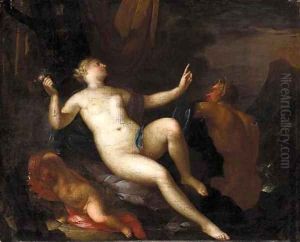Mattys Terwesten Paintings
Mattys Terwesten was a Dutch painter, draughtsman, and tapestry designer born on May 26, 1670, in The Hague, Netherlands. He was a member of a family of artists; his father, Augustinus Terwesten (1649-1711), was also a painter, and his younger brother, Augustinus Terwesten the Younger, pursued a similar career. The Terwestens were known for their contributions to the decoration of buildings and for their tapestry designs.
Mattys initially trained under his father's guidance before going on to further his education in the workshop of the prominent painter Willem Doudijns. His early work is noted for its adherence to the classical and Italianate styles prevalent in the Dutch Golden Age. In 1692, he traveled to Italy, which was a common practice among artists of the time seeking to study the works of Renaissance masters first-hand. Here, he spent time in Rome, where he was influenced by the grandeur of Italian art and architecture.
Upon returning to The Hague in 1694, Terwesten became a member of the local painters' guild and established himself as a capable artist in his own right. He received several important commissions for decorative works in public buildings, such as the town hall in The Hague, where he painted allegorical and mythological scenes. Terwesten's style evolved to include more baroque elements, characterized by dramatic lighting, rich colors, and dynamic compositions.
Terwesten also worked as a tapestry designer, which was a prestigious and lucrative field at the time. His designs showcased his skill in composition and his ability to translate painterly techniques into the medium of woven textiles. Throughout his career, he taught and influenced a number of younger artists, thereby contributing to the continuation of artistic traditions in the Netherlands.
Mattys Terwesten died on August 12, 1757, in The Hague. His legacy is preserved in the works he left behind, which can be found in various museums and collections in the Netherlands and beyond. Though not as widely known as some of his contemporaries, Terwesten's contributions to Dutch art during the late 17th and early 18th centuries remain an important part of the cultural heritage of his homeland.
